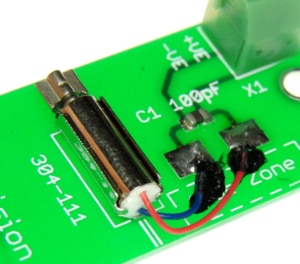Through-Hole Vibration Motors
Through-hole PCB-mounted vibrating motors offer a sturdy printed circuit board (PCB) mounting method because they are secured by solder joints on both sides of the PCB. If the board is PTH (plated through-hole), then there will be further mechanical support from within the board.
Like other PCB-mounted vibration motors, they are a convenient way to integrate haptic feedback into existing products and applications without requiring a complete re-design of the products’ enclosure.
Whilst not as efficient to manufacture as SMD / SMT vibrator motors (because they can’t be added to boards with a pick and place machine), they can be wave soldered with other leaded components.
Our range of through-hole vibration motors come with two different types of electrical connection.
Through-Hole Electrical Connections
We offer stock thru-hole PCB mounted vibrator motors in both Ø4mm and Ø6mm. These motors are designed to work on double-sided FR4 0.8mm PCB boards, though if through-hole plating and suitable pad sizes are used, they can also be used on the more common 1.6mm thickness boards.
Probably the main benefit of using through-hole vibration motors over SMD types is that it is possible to solder them to boards after washings or coatings have been applied. Motors cannot be exposed to liquids and so if boards need to be washed/coated, the motor will need to be added as part of a second process; this is easier with a through-hole component than an SMT type.
A secondary benefit is that one can place a capacitor very close to the motor terminals, and hence commutator circuitry if there is any concern over EMI radiation; it’s best practice to add a small ceramic capacitor or X2Y filter, but due to the low inductance of the motor windings, not strictly necessary.

Through-Hole PCB Vibration Motors With Flying Leads
In some designs, flying leads are the best way to go. For example, it might be convenient for the motor to be secured to a PCB, but take power from another PCB in the application. We currently offer several Ø4mm types of these thru-hole mounted vibration motors. A plated spring steel carriage securely holds the motor in place, and the flying leads can then be attached to a board. Since the vibration from the motor can cause metal fatigue in the thin wires, we suggest the following wire-to-board connection methods:
- Wires soldered directly to pads (this is only recommended if the wires are additionally secured to the board, e.g. via adhesive),
- Wires crimped to solderable pins (since now the crimp pins take the strain),
- Traditional wire to board connectors.

Get in touch
Speak to a member of our team.
Motor catalogue
Looking for our products?
Reliable, cost-effective miniature mechanisms and motors that meet your application demands.
Discover more
Resources and guides
Discover our product application notes, design guides, news and case studies.
Case studies
Explore our collection of case studies, examples of our products in a range of applications.
Precision Microdrives
Whether you need a motor component, or a fully validated and tested complex mechanism – we’re here to help. Find out more about our company.